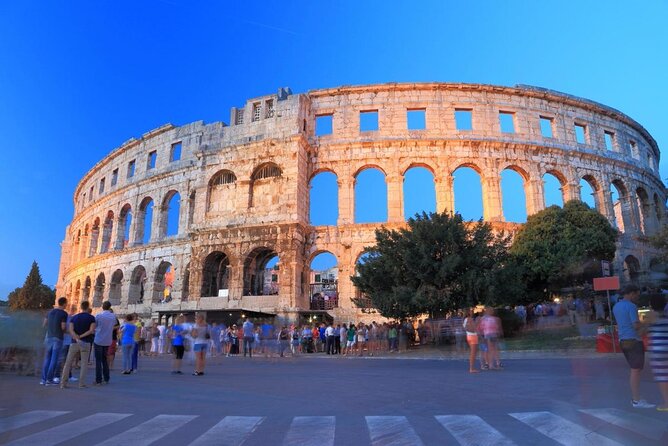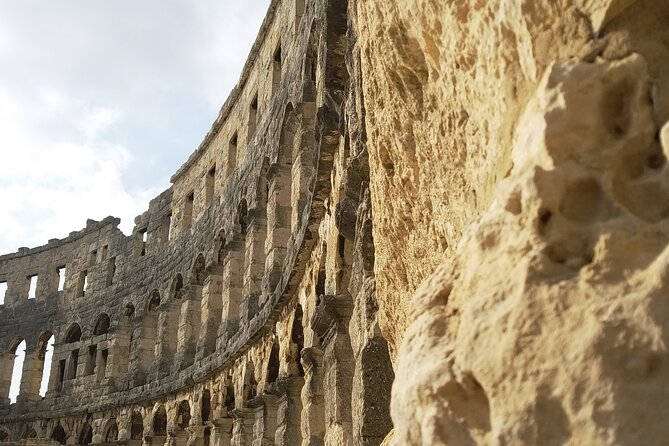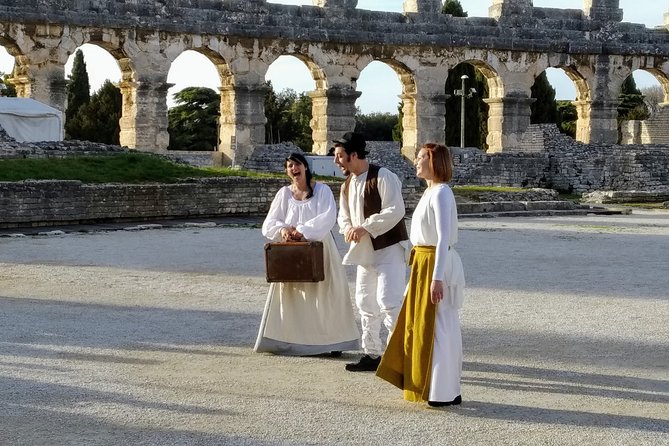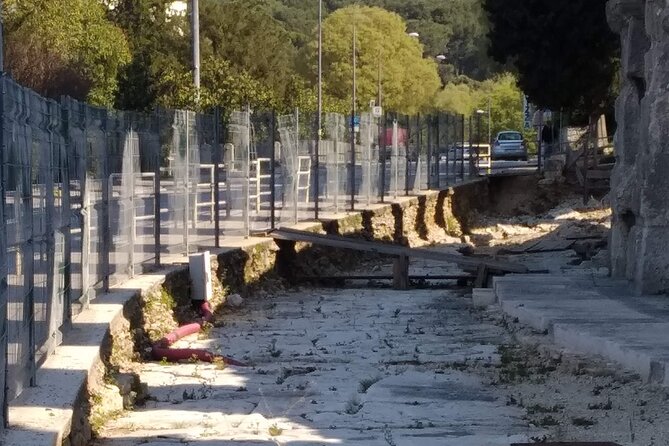Pulas Amphitheatre and Gladiators Life During Ancient Rome
With a history steeped in intrigue and bloodshed, Pula’s Amphitheatre stands as a formidable symbol of ancient Rome’s prowess. The echoes of cheers and clashes of steel once reverberated through its colossal walls, painting a vivid picture of gladiators’ existence in the arena.
But what truly lay beneath the gladiators’ stoic facades and the spectators’ fervor for battle? Unveiling the complexities of life and death in this amphitheatre promises a journey through time, where valor and sacrifice intertwine in a spectacle that continues to captivate curious minds today.
Key Points

- Pula’s Amphitheatre symbolizes Roman power and hosted gladiatorial contests and chariot races.
- Gladiators epitomized valor, skill, and underwent rigorous combat training in ancient Rome.
- The architecture of Pula’s Amphitheatre showcases Roman engineering mastery and cultural significance.
- Spectators at the Amphitheatre experienced electrifying battles, gladiator duels, and meticulously planned events for engagement.
History of Pulas Amphitheatre

Located in present-day Croatia, Pula’s Amphitheatre stands as a remarkable testament to the grandeur of ancient Roman architecture. Built between 27 BC and 68 AD, this well-preserved arena once hosted gladiatorial contests, chariot races, and other public spectacles.
The historical significance of the Amphitheatre lies in its role as a center of entertainment and a symbol of Roman power in the region. It provided a venue for the training and battles of gladiators, who were revered and sometimes feared figures in Roman society.
The structure’s elliptical shape, with its towering walls and underground chambers, offered a dramatic setting for these events, captivating audiences with the bravery and skill of the combatants.
Gladiators: Life and Battles

Gladiators in ancient Rome epitomized valor and skill as they engaged in fierce battles within the grand walls of arenas like Pula’s Amphitheatre. These warriors underwent rigorous training to perfect combat techniques, preparing for the intense fights that awaited them in the arena. The life of a gladiator was one of discipline and dedication, honing their agility, strength, and weapon proficiency. The table below illustrates the emotional journey of a gladiator, from the adrenaline-fueled entrance into the arena to the moment of truth in combat.
| Emotion | Description |
|---|---|
| Anticipation | Heart racing, crowd cheers |
| Fear | Adversary’s fierce gaze |
| Triumph | Victory amidst applause |
Architecture and Design Features

Ancient Roman architecture at Pula’s Amphitheatre mesmerizes visitors with its intricate design features that reflect the grandeur and engineering mastery of the era.
The construction techniques employed in the amphitheatre, such as the innovative use of arches, vaults, and concrete, showcase the advanced engineering skills of the ancient Romans.
The cultural significance of the amphitheatre is evident in its role as a hub for entertainment, hosting events like gladiatorial contests and other spectacles that were central to Roman society.
The design elements, including the tiered seating arrangement and the elaborate facades, not only served functional purposes but also added to the overall aesthetic appeal of the structure, making it a symbol of Roman architectural prowess and cultural heritage.
Spectator Experience and Events
Enjoy the electrifying atmosphere of the amphitheatre as spectators eagerly anticipate the thrilling events unfolding before their eyes. Gladiator training was a crucial aspect of the entertainment experience, with fighters showcasing their skills and prowess in combat.
The audience would witness these intense battles, cheering for their favorite gladiators as they engaged in fierce duels. The events were meticulously planned, offering a variety of matchups to keep the spectators on the edge of their seats.
From one-on-one combat to wild animal hunts, each spectacle was designed to captivate the crowd and provide an unforgettable experience. The amphitheatre’s design ensured that every seat had a clear view of the arena, allowing everyone to be part of the action-packed events.
Preservation Efforts and Visitor Info
Preserving the rich history of the amphitheatre, visitors can explore detailed information on guided tours and access essential visitor services for an immersive experience at Amphitheatre de Pula.
- Engage in interactive preservation efforts like archaeology workshops to learn about ancient Roman techniques.
- Discover the amphitheatre’s history through virtual reality experiences that bring the past to life.
- Enjoy the gladiator’s world with hands-on activities like gladiator training sessions.
These engaging opportunities not only enhance the visitor experience but also contribute to the ongoing preservation of this iconic ancient site. Whether you’re a history enthusiast or simply curious, these initiatives ensure a memorable and educational visit to the Amphitheatre de Pula.
Common questions
Can Visitors Participate in Any Gladiator Reenactments or Events at the Amphitheatre?
Visitors can engage in gladiator training and participate in historical reenactments at the amphitheatre. Interactive experiences offer a glimpse into ancient Rome’s thrilling life. The chance to embody a gladiator awaits, providing an immersive journey back in time.
Are There Any Ghost Stories or Legends Associated With the Pula Amphitheatre?
There are numerous ghost stories and legends associated with the Pula Amphitheatre, adding an air of mystery to the ancient site. Visitors can explore these eerie tales during VIP tours, all while exploring the secrets of the amphitheatre.
Are There Any Hidden Tunnels or Underground Chambers Beneath the Amphitheatre?
Hidden passageways and underground chambers beneath the amphitheater have intrigued experts. Recent archaeological discoveries shed light on these mysterious features, offering insights into the structure’s complexity. Visitors can explore these historical marvels during guided tours.
Is There a Specific Dress Code or Attire Required for Visitors Attending Events at the Amphitheatre?
There is no specific dress code required for visitors attending events at the amphitheatre. However, historical costumes can add to the experience of Gladiator contests. Amphitheatre etiquette should be followed, and embracing ancient fashion can enhance the atmosphere.
Are There Any Special VIP or Behind-The-Scenes Tours Available for Visitors Interested in Learning More About the Amphitheatre’s History and Secrets?
For those seeking VIP experiences and uncovering historical secrets, exclusive behind-the-scenes tours are available. Delve deeper into the amphitheatre’s captivating past with knowledgeable guides, unlocking hidden stories and intriguing details along the way.
Last Words

Step back in time and learn about the world of ancient Rome at Pula’s Amphitheatre. From the thrilling battles of gladiators to the stunning architecture of the arena, this historic site offers a glimpse into a bygone era filled with honor and glory.
With its well-preserved structure and rich history, a visit to Pula’s Amphitheatre is sure to leave you captivated by the fascinating stories and secrets hidden within its walls. Don’t miss out on this unforgettable experience!